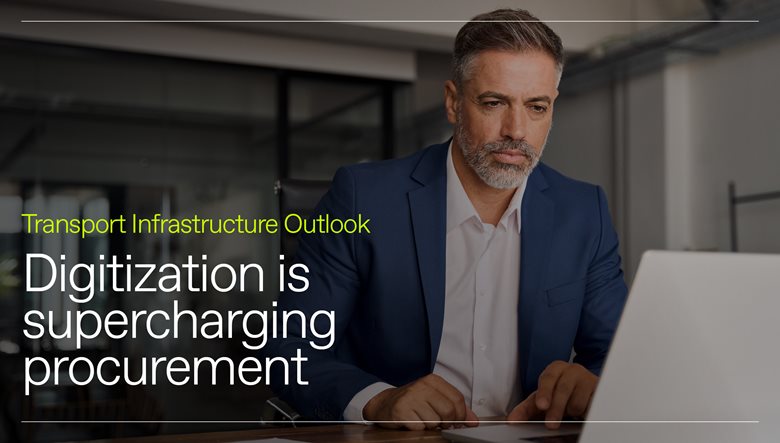Digitization supercharges transport infrastructure procurement
The latest AI tools and big data are turning a traditionally slow-moving sector into a global technology powerhouse.
By AnsaradaTue Jun 24 2025Industry news and trends, Innovation, Tenders

Digitization is transforming major project procurement and the transport infrastructure sector stands to benefit as outmoded analogue processes and practices are superseded. But the path to transformation can be rocky. Budget constraints, siloed systems and a reluctance to embrace the new can prevent organizations from making the switch.
As a result, they’re unable to enjoy the significant benefits digitized procurement can deliver, namely improved collaboration, faster and more robust planning and procurement, and substantial cost savings.
Drawing on our 2025 Transport Infrastructure Outlook Report, developed in partnership with Infralogic, this blog explores these benefits and outlines strategies leaders and internal stakeholders can employ to overcome barriers to adoption and drive meaningful change.
1. Technology investments deliver savings
In straitened economic times, public sector entities are under pressure to find ways to make their budgets stretch further. Against that backdrop, procurement tools which automate labor intensive tasks such as compliance tracking aren’t an unwelcome outlay; they’re a sensible investment that can help contain overheads and enable project staff to be redeployed to higher value activities.
Consequently, 52% of government agencies and 42% of all survey respondents cite cost reduction as the leading benefit of digital procurement. Private sector players are alive to the advantages too: they’ve registered the fact that project headcounts can be reduced by an extraordinary 75% when routine tasks are automated.
“The future lies in integrating AI and automation to handle repetitive administrative tasks, freeing up procurement teams to focus on strategic decision making,” EY Ireland Partner, Infrastructure and Capital Projects, Tom Carey says.
2. Working smarter and faster with digital tools
Major transport infrastructure initiatives can be a decade or more in the making. Typically, they’ll require the input of hundreds of stakeholders. Communication and collaboration challenges can slow the planning and procurement processes, adding months and years to project timelines.
Cloud based procurement technology can help organizations take that time back. It enables them to disseminate data digitally, centralize feedback, automate version control and shrink approval cycles. That earns it the tick of approval from public sector entities and advisory firms alike. More than a third cite improved stakeholder communications as a key advantage.
“As workloads increase and complexity grows, these tools will become indispensable for managing infrastructure projects,” Carey predicts.
3. Overcoming the budget barrier
But before that can happen, organizations will need to overcome the stubborn financial hurdles that continue to stymy widespread digital transformation.
Despite the demonstrable benefits and compelling returns digital procurement software can deliver, 37% of survey respondents say budget limitations are their chief barrier to adoption.
All too often, this enabling technology is viewed by decision makers as a discretionary and unnecessary expense, rather than the investment in efficiency and productivity it’s been proven to be.
Public sector entities’ collective reluctance to mandate the use of digital technology during the bidding process compounds this challenge, with advisers that wish to adopt it effectively required to absorb the cost.
It’s short sighted thinking that needs to change, Ansarada Business Development Director ANZ Craig McMahon says: “There’s a tangible ROI when you use a purpose-built solution that ultimately positively impacts the overall budget of a project.”
4. Siloed data and skills gaps
Internal skills deficits are another impediment to procurement transformation. More than a third of organizations say they lack the expertise to implement digital tools effectively. Doing things as they’ve always been done – with spreadsheets, emails and other legacy tools – is their preferred mode of operation and is likely to remain so, in the absence of effective education and change management initiatives.
Siloed data is another roadblock for 35% of organizations and one that’s well worth tackling. This factor alone was responsible for an 18-month delay in the delivery of one US port expansion project. Conversely, Australia’s level crossing removal project saw a 60% improvement in approval times following the establishment of a centralized digital data repository.
5. A growing appetite for change
Demonstrating how digital procurement tools can simplify workflows and save time and money, without downgrading or displacing skilled personnel, will be the key to increased adoption across the technologically conservative infrastructure and construction sectors.
Close to three quarters of survey respondents profess to be open to change, for a range of reasons. In the Asia Pacific region, rapid urbanization is driving demand for scalable procurement solutions while compliance-focused entities across EMEA place a high value on software that boosts auditability and data security.
“While adoption will take time, especially in the public sector, the need for scalable efficient solutions is clear,” EY’s Carey says. “As complexity in infrastructure grows, digital innovation will be critical to meeting future demands.”
Strategies to drive the successful embrace of digital procurement
The case for change is a compelling one and forward-focused stakeholders must continue to make it: reframing mindsets by highlighting the long term ROI digitized procurement can deliver; advocating for pricing models which make provision for new generation tools and technologies; educating and upskilling procurement teams; and exploring robust, secure platforms and programs that can unify siloed systems, accelerate the procurement process and drive better project outcomes.
For agencies and firms that are willing to abandon old practices and embrace the new, the rewards are real and well within reach.


